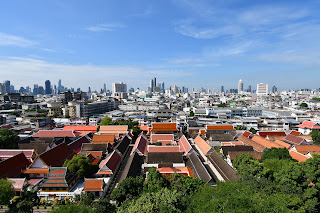New Adventures in Bangkok
After a few weeks working as a research assistant at Oxford, I had the good fortune of finding a job to bring me back to Asia. My position began online towards the beginning of the month, and my visa was approved shortly afterwards. I arrived in Bangkok on the 27th of June. Careful as I am never to let myself form idealistic expectations of my travel destinations, I was surprised when – in the land of smiles – one of the guards at immigration hit me on the arm and pointed in front of me. He only spoke Thai, and the gesture meant to convey the simple and unnecessary instructions that I should move forward in the queue by about five centimetres. Thankfully, my carefulness not to form idealistic expectations of countries is matched by an equally strong resolution not to judge them by first impressions.
This was
the only unpleasant experience of the evening. It could have been much more
troublesome, for I had been sternly warned to make sure the stamp on my
passport matched the electronic visa I had received. Leaving nothing to chance,
I slid the immigration official my electronic visa before I gave him my
passport and loudly stressed both the type and duration. That done, I picked up
my luggage, exchanged some money, bought a month-long phone plan, and queued up
for a taxi. Nothing very remarkable happened that night, except that when the
taxi arrived at my hotel, the security guards immediately rushed towards it and
checked the interior with flashlights.
My first
day in Thailand was a Friday, and although that would usually have been a
workday for me, my boss was very understanding of my request to take a day off
for errands. I had forgotten my shaving cream and belt at home, and I would
also need to buy more sunscreen and exchange more money. The biggest priority,
however, was to find long-term accommodation. Stopping by a 7-Eleven to buy my
necessities, I made my way to an apartment complex that had not responded to my
earlier email enquiries. I discovered the reason in person: the rooms were
hopelessly booked out until next year. I thus moved on to plan B – walking
around various sights and doing the rest of my errands while leaving the apartment
hunt for the afternoon.
From where
I stood, the closest attraction was the Golden Mount, a stupa (or chedi, in
Thai) perched on a massive white pedestal. The Golden Mount was initially
conceived by Rama III in the early nineteenth century as a giant chedi.
However, the structure was never completed and dilapidated into a hill, on top
of which a smaller chedi was build by Rama IV. In later years, the smaller
chedi was covered in gold and the hill itself received concrete fortifications.
The larger complex of Wat Saket, within which the Golden Mount is located, is
also famous for its grimy history. Located just outside Bangkok’s city walls,
this is where dead bodies used to be taken for cremation. In times when cholera
outbreaks ravaged the city, however, the crematoria could not keep up with
demand and the corpses were eaten by vultures instead.
After
climbing the mount (whose very top was undergoing renovations), I started
returning north when I was stopped by a local. As I would learn over the next
few encounters, many tourist sites and busy intersections are populated by a
class of people who channel tourists towards tuk-tuks. The story I have heard
from them is that the government is trying to incentivise tourism, which has
enabled tuk-tuk drivers to follow long itineraries for the negligible sum of 50
baht.
My own
experience has cast a little doubt on this narrative. I agreed to take the
cheap ride, as the driver suggested taking me to Wat Intharawihan, which would
otherwise have been rather out of the way for me. To pad out our itinerary, he
made a stop by Wat Sunthon Thammathan – a minor temple tracing its origins to a
relic brought from Ayutthaya – after which we drove on to a clothes store. I
was initially reluctant to include this stop, but the driver persuaded me to
stay for ten minutes, as the owners of the store were giving out free petrol to
tuk-tuk drivers. I also figured that I would be able to buy a belt there, and
this assumption proved to be correct.
Finally, we
arrived at Wat Intharawihan, a royal temple famous for its 32-metre-tall golden
Buddha statue. Begun in 1867, the statue took sixty years to build, and the
topknot houses a relic gifted by the government of Sri Lanka. It occurred to me
at this temple that either some Buddhist celebration was going on or Thai
people are extraordinarily devout. Many temples, with Wat Intharawihan being a
good example, were receiving a steady flow of visitors and had marquees set up
to shield them from the sun.
For a small
tip, I asked my driver to drop me off at Wat Chana Songkhram
Ratchaworamahawihan, a temple best known for its lavish interior and historical
significance. Its origins date to the eighteenth century, when it was set up as
a temple for resident monks of Mon ethnicity. Its name became Wat Chana
Songkhram (or War Victory Temple) following several Thai victories against
Burma after the latter had destroyed Ayutthaya in 1767. The temple is close to
another religious centre: Wat Bowonniwet Vihara, which houses a golden chedi
and serves as the final resting places for the ashes of Kings Rama VI and Rama
IX of the currently reigning Chakri dynasty.







































Comments
Post a Comment